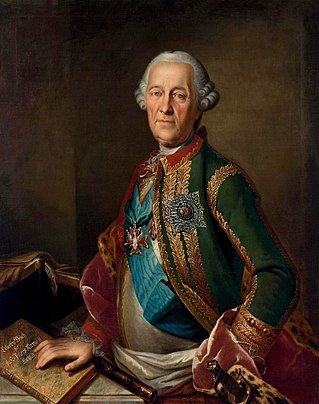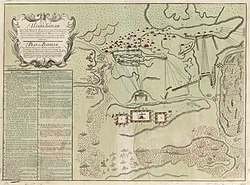
Burkhard Christoph Graf von Münnich was a German-born army officer who became a field marshal and political figure in the Russian Empire.

The Russo-Turkish War of 1735–1739 between Russia and the Ottoman Empire was caused by the Ottoman Empire's war with Persia and the continuing raids by the Crimean Tatars. The war also represented Russia's ongoing struggle for access to the Black Sea. In 1737, the Habsburg monarchy joined the war on Russia's side, known in historiography as the Austro-Turkish War of 1737–1739.

The siege of Kars was the last major operation of the Crimean War. In June 1855, attempting to alleviate pressure on the defence of Sevastopol, Emperor Alexander II ordered General Nikolay Muravyov to lead his troops against areas of Ottoman interest in Asia Minor. Uniting disparate contingents under his command into a strong corps of 25,725 soldiers, 96 light guns, Muravyov decided to attack Kars, the most important fortress of Eastern Anatolia.

The storming or battle of Kinburn was fought on 11–12 OctoberN.S./30 September – 1 OctoberO.S. 1787 as part of the Russo-Turkish War (1787–1792).

The Battle of Măcin took place during the Russo-Turkish War (1787–1792), fought on 9 July 1791 between the Ottoman Empire and the Russian Empire. The Russian army of 30,000 was commanded by Prince Nicholas Repnin, whereas the Turks, numbering about 80,000 men, were led by Koca Yusuf Pasha.

The Khotyn Fortress is a fortification complex located on the right bank of the Dniester River in Khotyn, Chernivtsi Oblast (province) of southwestern Ukraine. It lies within the historical region of northern Bukovina, a Romanian territory occupied in 1940 by the Soviet Union following the Molotov–Ribbentrop Pact. The fortress is located near another famous defensive structure, the Kamianets-Podilskyi Castle. Construction of the current stone Khotyn Fortress began in 1375. The fortress underwent significant improvements in the 1380s and in the 1460s under the Moldavian princes Alexander the Good and Stephen the Great.
Iliaș Colceag was a Moldavian mercenary and military commander in the Ottoman and Russian Empire.

The Shamkhalate of Tarki, or Tarki Shamkhalate was a Kumyk state in the eastern part of the North Caucasus, with its capital in the ancient town of Tarki. It formed on the territory populated by Kumyks and included territories corresponding to modern Dagestan and adjacent regions. After subjugation by the Russian Empire, the Shamkhalate's lands were split between the Empire's feudal domain with the same name extending from the river Sulak to the southern borders of Dagestan, between Kumyk possessions of the Russian Empire and other administrative units.

The siege of Ochakov (1737) took place during the Austro-Russian–Turkish War (1735–39) in which the Russian army, led by Burkhard Christoph von Münnich, captured the Ottoman fortress of Ochakov. It took place in 1737.

Kazimir Vasilyevich Levitsky was an Imperial Russian general and division commander. He took part in the war against the Ottoman Empire.

Georgy Ivanovich Bobrikov was an Imperial Russian division commander. He was the brother of Nikolay Bobrikov. He had another brother, Ivan (1835-1880). He fought in World War I against the Ottoman Empire. After the October Revolution of November 1917, he emigrated to Switzerland.

Nikolai Alexeyevich Epanchin was an Imperial Russian division and corps commander. He fought in World War I against the Ottoman Empire.

The Azov Fortress is a fortified complex in Azov, Rostov Oblast, Russia, overlooking the Don River and the Port of Azov to the north. It includes a rampart, watchtowers and gates. The Azov Fortress was founded by Turks on behalf of the Ottoman Empire in 1475. It guarded the northern approaches to the Empire and access to the Azov Sea. After a series of conflicts, a peace treaty was signed in Constantinople on July 13, 1700 between the Tsardom of Russia and the Ottoman Empire. The sultan recognized Russia's possession of the Azov area.

Fappi or Fappi mokhk, exonym: Kistetia, is a historical region in Ingushetia. Fappi is the territory of historical settlement of the Fyappiy society.

The Dzherakh, also spelled Jerakh, historically also known as Erokhan people, were a historical Ingush ethnoterritorial society, today a tribal organization/clan (teip), that was formed in the Dzheyrakhin gorge, as well as in the area of the lower reaches of the Armkhi River and the upper reaches of the Terek River.

Khamkhins, also known as Ghalghaï, were a historical Ingush ethnoterritorial society, which was located in the upper reaches of the Assa River. The Khamkhin society, like the Tsorin society, was formed from the former "Ghalghaï society" as a result of the transfer of rural government to Khamkhi.

The Battle of Azov (1736) was fought during the Austro-Russian–Turkish War (1735–39)

The Battle of Dobruja was fought during the Russo-Turkish War on 8 April to 4 September 1809 between Russian Empire and the Ottoman Empire.

The siege of Akkerman took place in 1770 between 24 September and 6 October.
The capture of Bergamo during Suvorov's Italian campaign, War of the Second Coalition, when 2 Don Cossack regiments of Prince Bagration's vanguard under the command of Colonel Grekov and Ataman Denisov quickly and unexpectedly attacked the town of Bergamo occupied by the French garrison and seized Citadel of Bergamo. The attack proved successful for the Russians. The French army was led by Barthélemy Schérer.

















